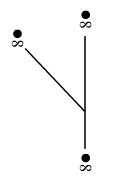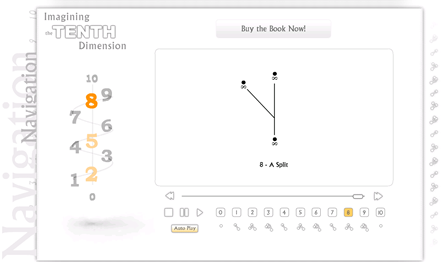We live in a 10-dimensional world
Wednesday, December 27, 2006

The majority of theoretical physicists now a days have come to the conclusion that to understand our universe we need 10 dimensions and not the 3 typical laid out by our Greek ancestors.
It is easy for us to visualize 3 dimension, as this is the way we live: things have a width, length, and height. In fact, the x, y, and z axis of Cartesian coordinates is all we need to visualize stuff.
Even the 4th dimension is somewhat easy to conceptualize, for example, I can tell you "meet me at the 18th floor of 1 Yonge St. at 3:00 PM on December 28, 2006" and you will know exactly what I mean. With this trivial example I have covered 4 dimensions: width, length, height, and time. Visualizing 4 dimension is rather impossible, as we can't really "see" 4 dimension, but we
have found ways to "fake" it.
What do the other 6 dimension do? Or how to even visualize them?
I won't claim to understand string theory, however, I'm very curious about the theory of everything (M) and I find the idea of parallel universes fascinating, which is in fact the predominant theory of how the big bang came to be: two
branes collided against each other and here we are discussing its very consequences. And according to the same theory, there could be an infinite number of other "us" discussing or not discussing the same theme--the possibilities of there being infinite parallels universes is, well, infinite.
There is much to explain, but I won't go into the details as I'm sure I would screw it up at some point so I will leave the research to you. However, I found a flash movie that tries to explain what a 10-dimensional universe may look like.
I thought it was very ingenious, and I immediately tried to find out who came up with the idea. As it happens, there is a book written called "Imagining the Tenth Dimension." I haven't read the book, but did see the flash movie. It feels right, but I'm not an expert and the writer and creator is no physicist. In fact,
Rob Bryanton is a producer of sorts, a sound engineer, and the president of a company called
Talking Dog.
Is he, and in turn his visualization movie, credible? Well, he doesn't have the right credentials, but does it matter if he ends up being correct? Which I am not saying he is, but it is a very clever way to explain a very hard problem and very easy to understand, which is in the end the main flaw of the visualization (in my point of view): it is too easy.
However, other things seem easy once fully explained, for example, calculating areas and volumes for different shapes is second nature now thanks to Calculus (this was a very, very hard problem), and even 20th century concepts such as the photoelectric effect or relativity seem very simple to understand (they are not--there is much math involved), however, anyone can say that when a photon hits a metal plate an electron is let go because of the collision, or that time is actually relative. (In this case this anyone person is me, and any of the statements I made are particularly technical, however, they are not wrong--they have been simplified.)
My point is that just because the visualization of 10 dimensions has been simplified its very core by this gentlemen, it doesn't mean that he is wrong because the majority of us will understand it. However, I would like to see more of the evidence as to why his version is indeed correct. And this is the catch-22 for me: I don't want to buy the book because I know it won't be indepth enough to convince me that it is correct, however, I want to buy it just because it such a simple way to visualize a very hard problem.
For now, I will keep watching the flash movie. If in fact this is the correct way to look at our reality, it is quite an achievement:

Comments: